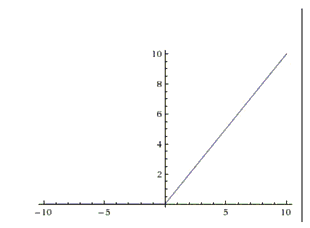caffe原始碼 之 Relu層
阿新 • • 發佈:2019-01-11
本文主要實現caffe框架中/src/caffe/layers/Relu_layer.cpp檔案,該檔案實現的是啟用函式Relu。
ReLU是近些年非常流行的啟用函式。相比於sigmoid與Tanh,它具有一定的優越性,這三者對比可見https://zhuanlan.zhihu.com/p/21462488?refer=intelligentunit,它的函式公式是f(x)=max(0,x)。換句話說,這個啟用函式就是一個關於0的閾值。如下圖:::
下面記錄我在看relu層時的程式碼註釋:::
Relu_layer.hpp:::
#ifndef CAFFE_RELU_LAYER_HPP_ Relu_layer.cpp:::
#include <algorithm>
#include <vector>
#include "caffe/layers/relu_layer.hpp"
namespace caffe {
/*Relu層的前向傳播函式*/
template <typename Dtype>
void ReLULayer<Dtype>::Forward_cpu(const vector<Blob<Dtype>*>& bottom,
const vector<Blob<Dtype>*>& top) {
const Dtype* bottom_data = bottom[0]->cpu_data(); //獲得輸入資料記憶體地址指標
Dtype* top_data = top[0]->mutable_cpu_data(); //獲得輸出資料記憶體地址指標
//輸入的blob的個數
const int count = bottom[0]->count();
//negative_slope是Leak Relu的引數,預設為0,就是普通的Relu函式。
//Leaky ReLU是為解決“ReLU死亡”問題的嘗試。
//一般的ReLU中當x<0時,函式值為0。禠eaky ReLU則是給出一個很小的負數梯度值,比如0.01。
//Leaky Relu公式如下 f(x) = max(x, 0) + alpha*min(x, 0) 其中alpha就是下面的程式碼中引數negative_slope
Dtype negative_slope = this->layer_param_.relu_param().negative_slope();
for (int i = 0; i < count; ++i) {
top_data[i] = std::max(bottom_data[i], Dtype(0))
+ negative_slope * std::min(bottom_data[i], Dtype(0));
}
}
/*Relu層的返向傳播函式*/
template <typename Dtype>
void ReLULayer<Dtype>::Backward_cpu(const vector<Blob<Dtype>*>& top,
const vector<bool>& propagate_down,
const vector<Blob<Dtype>*>& bottom) {
//propagate_down與計算bottom的梯度有關,在caffe的BP實現中非常重要
if (propagate_down[0]) {
//獲得前一層的前向傳播的資料記憶體地址
const Dtype* bottom_data = bottom[0]->cpu_data();
//獲得後一層的後向傳播的導數的記憶體地址(對於本層來說是輸入資料)
const Dtype* top_diff = top[0]->cpu_diff();
//獲得前一層的後向傳播的導數的記憶體地址(對於本層來說是輸出資料)
Dtype* bottom_diff = bottom[0]->mutable_cpu_diff();
//參與計算的blob個數
const int count = bottom[0]->count();
//見上面的Forward_cpu函式中關於這個引數的解釋
Dtype negative_slope = this->layer_param_.relu_param().negative_slope();
//這裡(bottom_data[i] > 0)實現的就是Relu的導數, 這是一個邏輯判斷,如果bottom_data[i]值大於0則(bottom_data[i] > 0)值為1,反之為0
//這裡((bottom_data[i] > 0) + negative_slope * (bottom_data[i] <= 0)) 實現的是Leaky Relu的導數
//根據求導鏈式法則,前一層(對於返向傳播前一層為輸出層)的導數對於上一層導數乘以當前層函式的導數
for (int i = 0; i < count; ++i) {
bottom_diff[i] = top_diff[i] * ((bottom_data[i] > 0)
+ negative_slope * (bottom_data[i] <= 0));
}
}
}
#ifdef CPU_ONLY
STUB_GPU(ReLULayer);
#endif
INSTANTIATE_CLASS(ReLULayer);
} // namespace caffe

